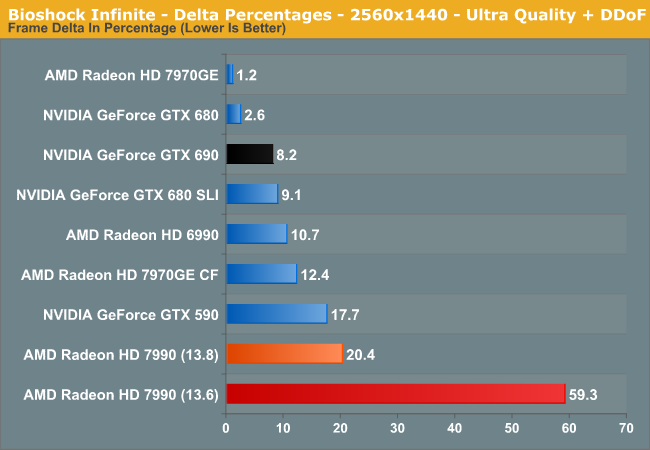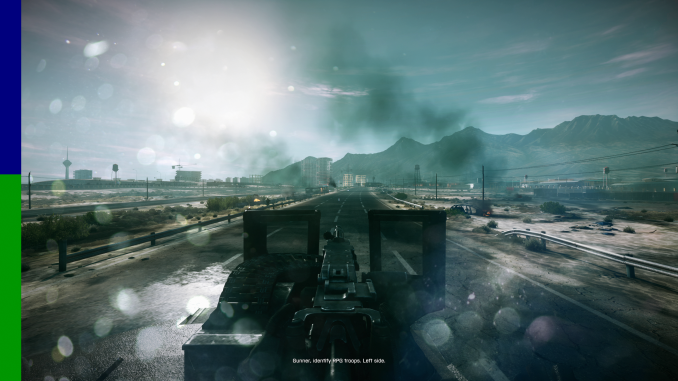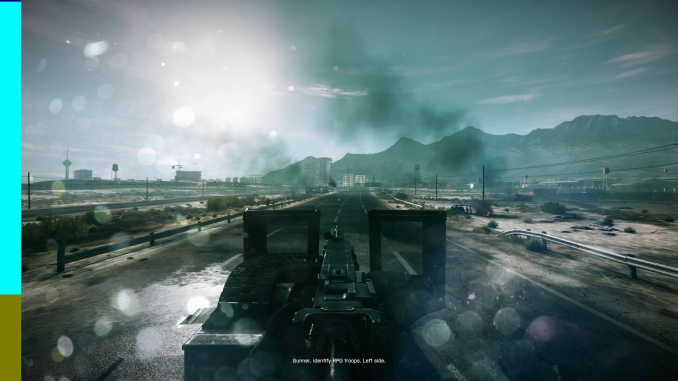AMD Frame Pacing Explored: Catalyst 13.8 Brings Consistency to Crossfire
by Ryan Smith on August 1, 2013 2:00 PM ESTThe Test
For the purposes of our testing we’ll be looking at the 6 games we’ve adopted for use with FCAT due to their proven reliability. These are Total War: Shogun 2, HItman: Absolution, Sleeping Dogs, Battlefield 3, Bioshock Infinite, and Crysis 3. All of our results unless otherwise noted are using Catalyst 13.8b1 for the AMD cards, and NVIDIA’s 326.19 beta drivers for the GeForce cards.
Our metric of choice for measuring frame times and frame pacing is a metric we’re calling Delta Percentages. With delta percentages we’re collecting the deltas (differences) between frame times, averaging that out, and then dividing delta average by the average frame time of the entire run. The end result of this process is that we can measure whether sequential frames are rendering in roughly the same amount of time, while controlling for performance differences by looking at the data relative to the average frame time (rather than as absolute time). This gives us the average frame-to-frame time difference as a percentage.

In general, a properly behaving single-GPU card should have a delta average of under 3%, with the specific value depending in part on how variable the workload is throughout any given game benchmark. 3% may sound small, but since we’re talking about an average it means it’s weighed against the entire run, as the higher the percentage the more unevenly frames are arriving. For a multi-GPU setup we’d ideally like to see the delta percentages be equal to our single-GPU setups, but this is for the most part unreasonable. There is no hard number for what is or isn’t right here, but based on play testing we’d say 15%-20% is a reasonable threshold for acceptable variance, with anything under 10% being very good for a multi-GPU setup.
Finally, in our testing we did encounter an issue with Catalyst 13.8 that required we make some slight adjustments to FCAT to compensate for this bug, so we need to make note of this. For reasons we can’t sufficiently explain at this time but has been confirmed by AMD, in some cases in Crossfire mode AMD’s latest drivers are periodically drawing small slices of old frame buffers at the top of the screen. The gameplay impact is minimal-to-nonexistent, but this problem throws off FCAT badly.
To quickly demonstrate the problem, below we have two consecutive frames from one of our Battlefield 3 runs. The correct FCAT color order here is dark blue, green, light blue, and olive. The frames corresponding to dark blue and green occur on frame one, and light blue and olive on frame two. Yet looking at frame two, we see a small 6 pixel high stripe of dark blue at the very top of the image. At this point the dark blue frame should have already been discarded, as the cards have moved on to the green and later light blue frames. Instead we’re getting a very small slice of a frame that is essentially 2 frames old.
The gameplay impact from this is trivial to none; the issue never exceeds a 6 pixel slice, only occurs at the top of the frame (which is generally skybox territory), and is periodic to the point where it occurs at most a few times per minute. And based on our experience this primarily occurs when a buffer swap should be occurring during or right after the start of a new refresh cycle, which is why it’s so periodic.
However the larger issue is that FCAT detects this as a frame drop, believing that over a dozen frames have been dropped. This isn’t actually possible of course – the context queue isn’t large enough to hold that many frames – and analysis shows that it’s actually part of the old frame as we’ve explained earlier. As such we’ve had to modify FCAT to ignore this issue so that it doesn’t find these slices and count them as dropped frames. The issue is real enough (this isn’t a capture error) and AMD will be fixing it, but it’s not evidence of a dropped frame as the stock implementation of FCAT would assume.
Ultimately our best guess here is that AMD is somehow mistiming their buffer swaps, as the 2 frame old aspect of this correlates nicely to the fact that the dark blue and light blue frames would both be generated by the same GPU in a two-GPU setup.
| CPU: | Intel Core i7-3960X @ 4.3GHz |
| Motherboard: | EVGA X79 SLI |
| Power Supply: | Antec True Power Quattro 1200 |
| Hard Disk: | Samsung 470 (256GB) |
| Memory: | G.Skill Ripjaws DDR3-1867 4 x 4GB (8-10-9-26) |
| Case: | Thermaltake Spedo Advance |
| Monitor: | Samsung 305T |
| Video Cards: |
AMD Radeon HD 6990 AMD Radeon HD 7970GE AMD Radeon HD 7990 NVIDIA GeForce GTX 590 NVIDIA GeForce GTX 680 NVIDIA GeForce GTX 690 |
| Video Drivers: |
NVIDIA ForceWare 326.19 AMD Catalyst 13.5 Beta 2 AMD Catalyst 13.6 Beta 2 AMD Catalyst 13.8 Beta 1 |
| OS: | Windows 8 Pro |












102 Comments
View All Comments
Feellia - Friday, August 2, 2013 - link
Not aimed at anyone, but flat out in any competitive game play the kind that has tourneys and pays out cash, Mostly fps such as quake..etc everyone has vsync off it flat out adds input lag...all the pros turn it off no matter what monitor is used, but no one is running a SLI/CrossfFire set up during these events.The pros typically lower settings quite damn low so they can push a steady 125fps and screen tearing is absolutely no concern. And if i have vsync on my aim % takes a nearly 25% dip
Anyway this is review is about duel+ cards, and kudos to AMD even though they still need a bit of work before going on a official non beta release = )
piwo - Friday, August 2, 2013 - link
can you check a10- 5750m with hd6670?dew111 - Friday, August 2, 2013 - link
I just got a second HD 7950, and this driver makes a HUGE difference! They should have done this earlier, but their timing was great for my first CrossFire setup :PJamesWoods - Sunday, August 4, 2013 - link
It's a crying shame they won't jump back to HD 4000 series or even HD 3000 series and fix these problems. I'm sure there is still quite a large loyal fanbase using these cards. I happen to own several systems with HD 4850's in them, and they can still set pace on a lot of modern games. Crossfire is another story. They never really felt optimized running in X fire.medi02 - Tuesday, August 6, 2013 - link
Is it me, or does nVidia have much lower min fps on a number of charts? =)transphasic - Tuesday, August 6, 2013 - link
Well done, AMD! You didn't bother to do anything about creating fixes for the single GPU setup, and basically ignored those w/o CF setups.You had 2 1/2 months without any new driver fixes, and THIS is the BEST you can do?
Major fail once again.
Thanks for nothing....
medi02 - Wednesday, August 7, 2013 - link
Exactly which single GPU setup is giving you micro stuttering problem?usrevenge - Wednesday, August 7, 2013 - link
Basically, AMD did a lot to fix the problems, but still leaves a lot of work to be done. I call these drivers a success.Nearox - Monday, August 26, 2013 - link
Does this technology also apply to the HD6000 series (and in particular the HD6950)? Could anyone say if this will also work for Skyrim? Thinking about getting a 2nd hand hd6950 to go xfire with this, seeing the good results from this AnandTech test.lopper - Wednesday, August 28, 2013 - link
A question: Does this driver fix stuttering on dual graphics configurations like A10 +6670?